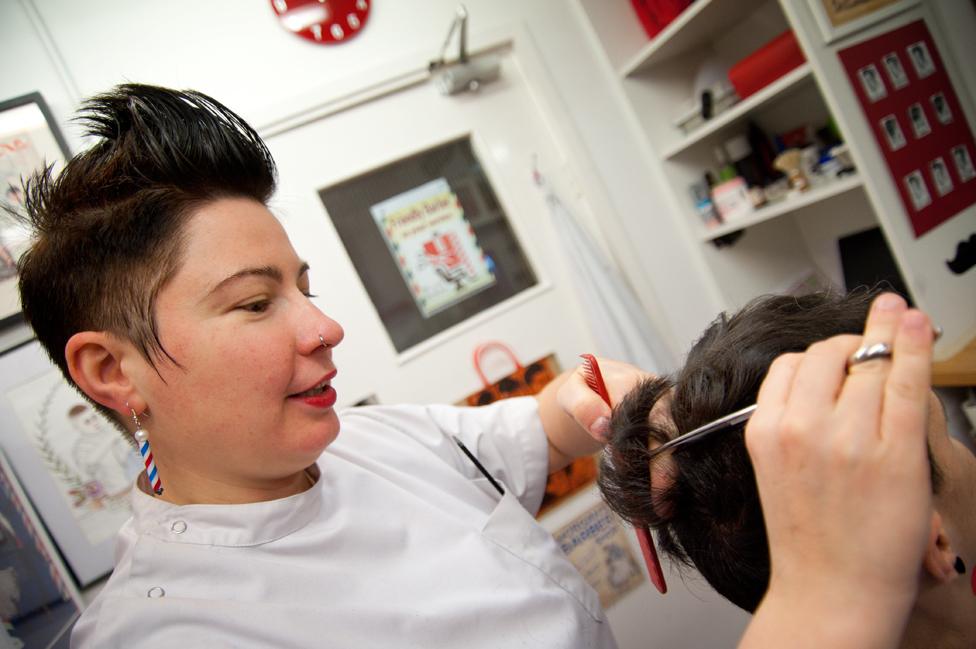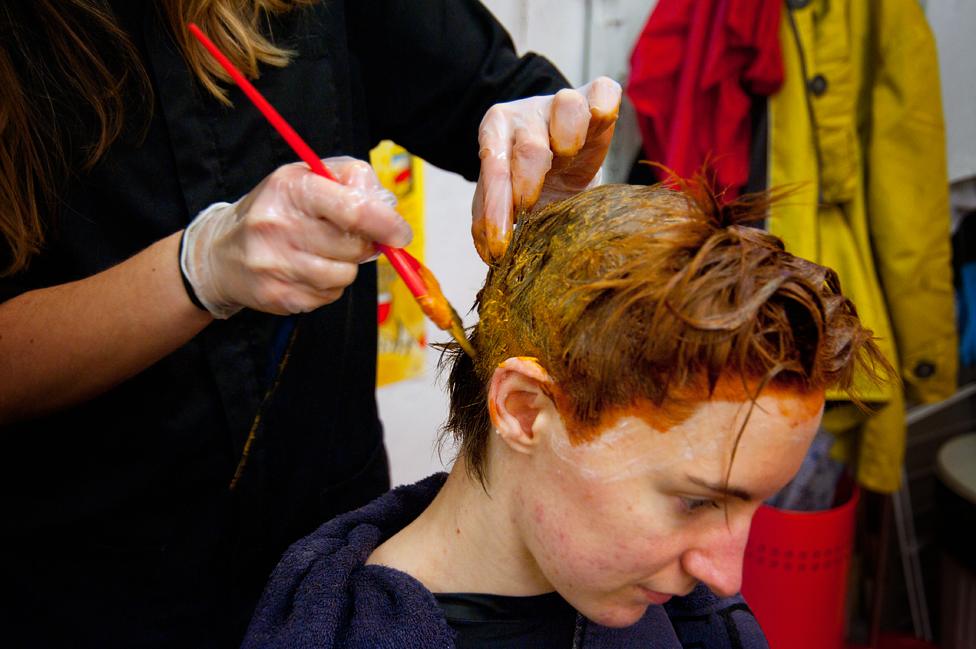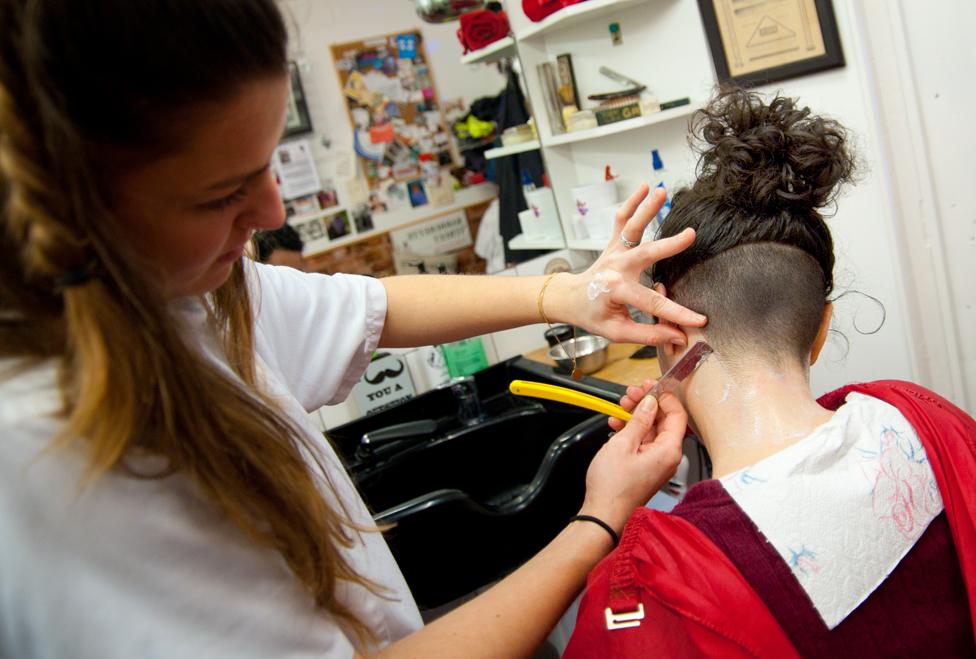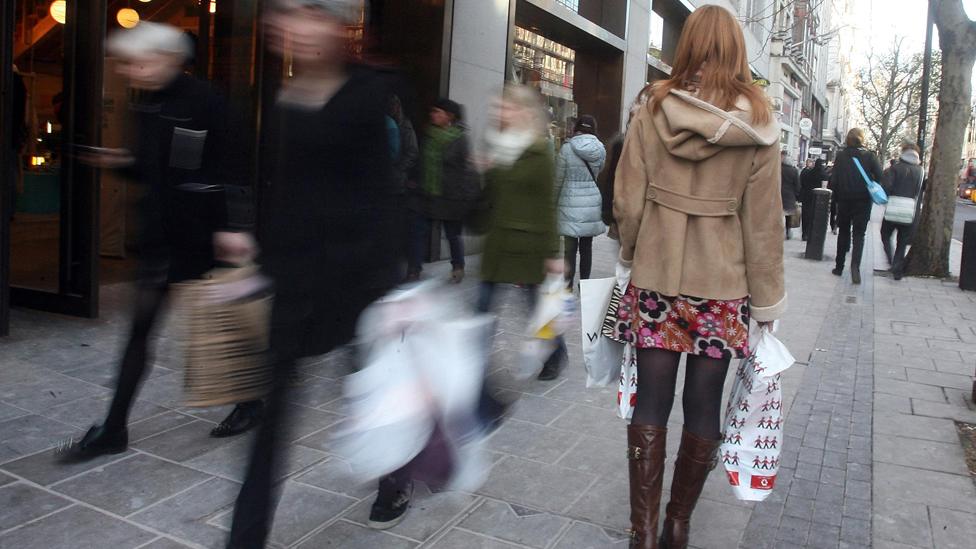Haircuts trimmed by gender-neutral pricing
- Published

Klara Vanova believes hairdressers should give customers the exact style they ask for
Coco Chanel once said a woman who cuts her hair is about to change her life.
The most immediate change she'll notice is a minor black hole in her finances.
The cost of a simple cut and blow dry for a woman is typically around £50 in London, though admittedly cheaper elsewhere. But it's almost always significantly less expensive if you're a man. Why?
The price of going to a hairdresser has traditionally been higher if you're a woman wanting an elaborate hairstyle, but as men become more choosy about their coiffure, that distinction no longer always holds true.
One barber shop in north London is joining a growing trend of charging for the style, not the gender of the head being coiffured.
Klara Vanova, originally from the Czech Republic, runs Barberette, in Hackney, which she describes as a "hairdressing hub, not a salon" and is a gender neutral barber shop.
She set up her business in 2012 "because of my experience having short hair myself".
"I have found it absolutely terrifying to go to the hairdressers and ask them for the haircut I want. They will persuade me that the haircut will look too masculine on me, or it will not suit me or it will be too short.
"We offer barber haircuts, which are sharp, clippered haircuts, as well as long hair or texturising haircuts and we don't put the gender on them. We put our foot down saying, well, why would you be charged more?
"So we offer the haircut the client wants, or if a woman wants very short hair, she knows she can come to us and we give her exactly that, as short as she wants or as long as she wants or as long as he wants."

The National Hairdressers' Federation says specialist techniques can require different pricing
Klara also says it is "unbelievable" that hairdressing remains a "very genderised profession" in an age when identity is broken down not only into men and women but into lesbian, gay, bisexual, transgender and queer.
"We have a strong following from the LGBTQ community because they mostly find issues, or they find challenges at a hairdresser, again because it's so genderised. They didn't know where to go.
"Traditionally in hairdressing, women are charged much more than men, and if they challenge it then they say, oh, women's hair is different. So I would like to say, there is no difference between men and women haircuts or hair. It is just simply that in the hairdressing industry you will pay more if you are a woman."
The truth is it doesn't all boil down to how long it takes to style the hair. It's more to do with what economists call price discrimination: people who are willing to pay a higher price will end up being charged more. And women are often happier to spend more on their personal care than men, or were in the past.
But this particular curl of the hairdressing world might be getting straightened out.

Hairdressing, barbering and beauty industry

Contributes £7bn to UK economy
Provides flexible employment for 300,000 people (part-time and self-employed)
40,000 businesses in the sector - a quarter in London and the South East
Two-thirds of hairdressing, barbering and beauty businesses have annual turnover of less than £99,000
A quarter have turnover between £100,000 and £250,000
Hairdressing and barbering are fifth most popular independent start-ups, with salons eighth most popular
According to 2014 survey, average charge for a cut and blow dry was £35.59 and a cut, colour and blow dry was £89.54

A qualification was introduced by City and Guilds last year called Hairdressing and Barbering (NVQ) (6008),, external which it says "does not qualify [students] to be a barber, but does prepare them for working in a salon that carries out services on male and female clients".
And the Supercuts chain of hairdressers also has one price list, which applies to both genders. So, the company says, if you are a man with long hair, you'll pay the same price for a cut and blow dry as if you are female. Equally, a woman who wants a buzz cut pays the same as a male customer.
Jackie Lang, managing director of Regis UK which owns Supercuts, says this approach is growing in popularity among many hair and beauty salons.
"We are seeing the emergence of gender-neutral hair and beauty trends within the social landscape, so providing one generic pricing system helps us to promote fairness and equality throughout our salons," she said.

A new qualification is teaching students to work in salons which serve men and women
The Toni&Guy hairdresser chain charges more for women to receive a cut and blow dry than men, although prices do vary between different salons.
Its general manager, Brenda Mail, said the cost of its haircuts is determined by "the length of time you are in the salon and being looked after by a technician or stylist".
She added: "Traditionally, women would experience a longer appointment, due to the length of time it took to blow dry their hair and the techniques for cutting and colouring used.
"However, these days the difference in price for men and women is getting less all the time, as men are taking more and more time in the salon chair."

Some salons say the length of time spent on a woman's hair means they must pay more
A spokeswoman for the National Hairdressers' Federation (NHF), the UK trade body for the hairdressing, barbering and beauty business, said some services historically associated with female clients, such as perms and colour, are now becoming more common in men's hairdressing.
"The costs should not vary just because of their gender, so men using these more complex services can expect to pay the higher prices women typically pay to cover their stylist's time, skills and the products used," she said.
But the NHF says that one of the most common services for female clients is a cut, colour and blow dry, which can take two to three hours.
It says factors such as the varying costs of colouring hair, a detailed consultation process and an application involving "specialist techniques which can take years to master" means many salons separate the costs of service on their menus, whether for men, women or colour services.
"However, gender-neutral price lists do help to dispel the myth that men and women are charged different prices, and make it clear that the price reflects the amount of time taken, the skills needed and the products used, not the client's gender," the spokeswoman added.


As people become increasingly connected and more mobile, the BBC is exploring how identities are changing.
Catch up with programmes, downloads and clips from the season.
Where are you going? - The surprising answers to a simple question
Default World - The morals of the technical elite
Why I'm Not Just Blind - Must blind people be either inspirational or deserving pity?
Learn more about the BBC's Identity season, find all the programmes or join the discussion on Twitter using the hashtag #BBCIdentity, external.
- Published20 January 2016

- Published5 February 2016

- Published2 February 2016
